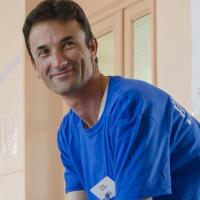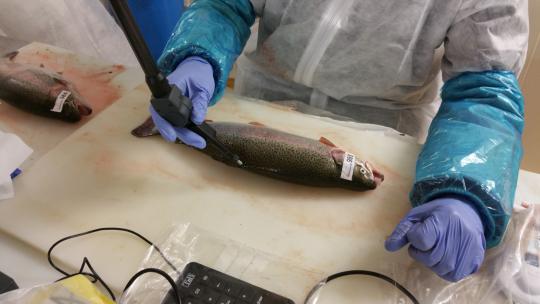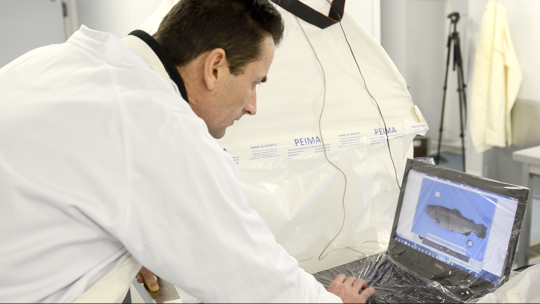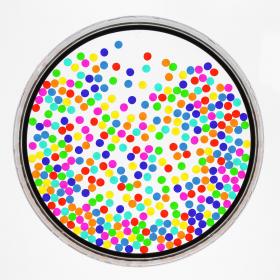
Food, Global Health Reading time 4 min
Jérôme Bugeon: fishing for innovative tools
Published on 09 April 2019
“I’m lucky to have a job with a lot of variety developing new methodologies, creating measurement tools and doing data processing in the office.” As an engineer at the Joint Research Unit for Fish Physiology and Genomics at INRA’s centre in Rennes, Jérôme Bugeon’s work is specifically focused on the quality of fish flesh. He has been working in this area since his master’s degree internship in animal production with a specialisation in aquaculture biology in 1997 at INRA’s Nantes centre. “Aquaculture seemed like a field with a future,” he says. His intuition turned out to be right, because nearly half of the fish consumed worldwide today is farmed. France is currently the fourth biggest European producer of rainbow trout, the leading species grown in France for its flesh and eggs. To address research needs as well as those of producers looking for the best parent stock, Jérôme has developed several simple, quick and inexpensive methodologies to measure the quality of fish flesh and eggs.
Designing measuring devices

For farmed fish, quality refers to fillet yield. But the biggest fish do not always produce the best product. “We have more precise indicators, such as the thickness of the abdominal wall and the depth of the abdominal cavity. A fish with a thick abdominal wall and shallow cavity is liable to yield larger fillets. Similarly, we noticed that an elongated shape is also a more favourable indicator.” These indicators can be measured by ultrasound in collaboration with the SYSAAF, the French union of aviculture and aquaculture breeders. However, Jérôme has developed simple tools using photographs and image processing.
He has also created a 3D imaging system. The device, which has a swivel arm linked to a software program, records coordinates in space of each point of the object being measured and recreates the image on the computer screen. “Applied to an anaesthetised fish, this system is an inexpensive way to obtain precise measurements about its general shape, thickness and head surface, for example,” says Jérôme.

A third methodology developed by Jérôme is a device1that can be used to assess various fish egg quality criteria, such as the number, shape, surface and colour. While eggs previously had to be manually counted, this device makes it possible to not only count them automatically but to also measure their individual size to assess the consistency of the spawn. “I get a lot of requests from researchers and professionals to use this device. And it’s just a basic digital camera and a backlit display on which the petri dish with the eggs is placed. Anyone can find these inexpensive tools on the Internet.” What this modest description leaves out is all of the effort that went into creating the software that also had to be developed to record and process the data.
Dual degrees in biology and computer engineering
After finishing his Master's degree and thesis in Fish Physiology and joining INRA in 2002, Jérôme completed several training courses in image processing. He became a specialist for his unit’s histology platform, and he now trains numerous colleagues and professionals on using the tools he has developed.

He is also involved in an international project called ATOL2for which he is creating a standardised vocabulary to describe meat quality for all species. More specifically, the aim is to define each meat quality characteristic, such as “fibrosity” or “tenderness”, by including the measurement protocol and all useful information. An ID number will also be assigned so that the characteristic can be unambiguously recognised in a bibliography or in databases. ATOL eventually plans to list and label all measureable data on animals, from meat, milk and egg production to health, reproduction and welfare information. “This project developed from what’s called the semantic web, where each piece of data is tagged, making it possible to find any publication that includes that information or to identify it in databases, therefore making them intelligible and shareable,” explains Jérôme.
Working for the greater good
Whether at the scale of a project such as ATOL or at team level, developing something with useful applications is one of Jérôme’s top priorities. Some research projects would simply not be possible without his expertise. This is the case of a theory on differentiating muscle cells that required counting the nuclei in each cell. It would have been impossible without image processing!
“Although I work on a variety of tasks and projects, they all fit together: I create tools, which I use to produce data, which I then share by participating in developing the semantic web,” he says seriously, in his typically matter-of-fact way.
1 VisEgg tool. Read the article
2 ATOL: Animal Trait Ontology for Livestock
CV in brief
46 years old, married with two children
Background
- Since 2002: Joined INRA Brittany-Normandy centre as a research engineer at the Joint Research Unit for Fish Physiology and Genomics, team: Fish Growth and Flesh Quality.
Education
- 1997-2001: PhD in Animal Biology, University of Rennes 1
- 1997: Master’s degree in Animal Biology and Production, specialisation in Aquaculture Biology, Rennes
- 1995: Master’s degree in Animal Physiology, University of Nantes
Hobbies
- Sea fishing, cycling, running
